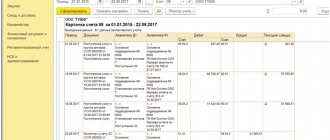In this article we will look at: depreciation of land in accounting and tax accounting. Let's find out whether it is possible to calculate depreciation of the asphalt pavement. We will answer your questions.
Companies acquiring land on a property basis are required to reflect the land on their balance sheet in accordance with the procedure for accounting for fixed assets. However, among owners who have purchased land, the question often arises: is it necessary to depreciate the cost of land and whether it is possible to reduce the taxable profit of the company in this way. You will find answers to these and many other questions regarding land depreciation in our article.
Land depreciation: general procedure
The most popular question among enterprises that have purchased a plot of land as their own is: do we need to take into account the wear and tear of the land? Tax legislation (Tax Code of the Russian Federation, clause 2, article 256) gives a clear and unambiguous answer to this question: in tax accounting, depreciation is not calculated on the cost of land, and depreciation on the site is not reflected. That is, the company that owns the land cannot reduce the basis for calculating income tax due to depreciation of the land.
The legislation substantiates its position as follows: land refers to environmental management objects (along with water and forest resources, subsoil, etc.), which, in turn, do not lose their properties over time. That is, in general, the consumer value of land is constant and unchanging. The position can be confirmed by the following example: a company that has purchased land for construction can use the site to locate a property for an unlimited amount of time (both after 20 and 50 years a building or other structure can be placed on the land).
Since the useful life of the land from a consumer point of view is not limited, there is no need to charge depreciation on the site. It turns out that in this case the land does not “wear out”, and its book value changes over time only due to improvements and revaluations.
As for accounting, in this case the provisions of PBU completely coincide with tax legislation. The position on non-accrual of depreciation on land in accounting is confirmed by PBU 6/01.
What is the useful life of land plots?
There are no special unified forms for recording land plots, so OS-6 is used.
Land plots are not subject to depreciation. In fact, this means that land plots have an unlimited useful life, therefore, when they are accepted for accounting as fixed assets, the useful life is not established.
The rationale for this position is given below in the materials of the Glavbukh System
1. Recommendation: How to register and reflect in accounting and taxation the receipt of land intended for construction
Acquisition of property
A developer can obtain ownership of a land plot by purchasing it under a purchase and sale agreement, an exchange (barter) agreement, receiving it as a contribution to the authorized (share) capital, or receiving it free of charge.
In this case, the object of the transaction can only be those land plots that have undergone state cadastral registration (Clause 1, Article 37 of the Land Code of the Russian Federation).
The owner of a land plot has the right to use it in accordance with the type of permitted use of the land plot specified in the State Real Estate Cadastre (Clause 1, Article 263 of the Civil Code of the Russian Federation, Article 37 of the Town Planning Code of the Russian Federation). Types of permitted use of land plots for capital construction are established in relation to the territorial zone.
Owners should take into account that the type of permitted use of the land plot determines the possibility of reconstructing existing buildings, as well as new construction on the land plot. It influences which buildings (buildings of what functional purpose) can be created on a given land plot. So, for example, a production workshop located on a land plot with the type of permitted use “for industrial production” cannot be reconstructed into a shopping center without changing the type of permitted use of this land plot.
To summarize information on the costs of the paid acquisition of a land plot, use account 08 (sub-account 08-1 “Acquisition of land plots”) (clause 27 of the Methodological Recommendations approved by Order of the Ministry of Finance of Russia dated October 13, 2003 No. 91n).
Otherwise, the procedure for recording the acquisition of a land plot in accounting depends on who finances the construction:
- attracted investor;
- developer who acts as an investor.
If the cost of a land plot acquired for the construction of an object is reimbursed at the expense of attracted investors (shareholders), the developer does not have the right to recognize it as a fixed asset, since in this case it does not comply with the conditions of paragraph 4 of PBU 6/01. Reflect the acquisition of land with the following entries:
Debit 08-1 Credit 60 – a plot of land was purchased for construction at the expense of investors (shareholders).
This procedure is established by the Instructions for the chart of accounts.
After completion of construction, the developer transfers this plot to investors or shareholders in accordance with the agreement and its cost is written off as settlements with them. For more information about this, see How to register and reflect in accounting and taxation the disposal of land for construction.
If the construction is financed by the developer, then the land plots received into ownership (except for lands acquired for resale), if all necessary conditions are met, he includes in accounting as part of fixed assets (clause 4, 5PBU 6/01).
The procedure for determining the initial cost, documentation and reflection in accounting depend on the method of obtaining ownership of land plots:
- for a fee;
- under a barter agreement;
- as a contribution to the authorized capital;
- free of charge.
Leased land: postings
If a company leases a site, then depreciation on it also does not need to be charged. The value of land received for temporary use should be reflected on the balance sheet. Depreciation must be charged only on fixed assets located on the leased site.
Example.
In April 2022, Focus JSC rented a plot of municipal property for the purpose of building a warehouse for its own use:
- book value of the plot – 1,050,704 rubles;
- the cost of the right to conclude an agreement with the municipality is 3,990,407 rubles. (paid in April 2017);
- The amount of state duty for registering a land lease agreement is 14,000 rubles. (paid in April 2017);
- start of construction of the warehouse - May 2022, commissioning of the facility - February 2022;
- useful life of the warehouse is 25 years;
- the period for writing off expenses for concluding an agreement with the municipality is 4 years;
- documents for state registration are dated 05/18/2017.
The following entries are reflected in the Focus accounting:
| date | Debit | Credit | Sum | Description |
| 05.04.17 | 08.3 | 76 | RUR 3,990,407 | The costs of drawing up a lease agreement for municipal land (the right to conclude an agreement) have been taken into account. |
| 05.04.17 | 76 | 51 | RUR 3,990,407 | Paid the cost of the right to conclude an agreement with the municipality |
| 05.04.17 | 08.3 | 68 State duties | 14,000 rub. | The costs of registering a land lease agreement are taken into account |
| 05.04.17 | 68 State duties | 51 | 14,000 rub. | The state fee for registering a land lease agreement has been paid |
| 05.04.17 | 001 | RUB 1,050,704 | The off-balance sheet reflects the cost of the municipal plot |
Until the premises are put into operation, the Focus accountant records monthly expenses for the right to enter into an agreement:
RUR 3,990,407 / 4 years / 12 months = 83.133 rub.
After putting the premises into operation, these expenses are reflected in tax accounting in order to reduce taxable profit.
Is the land plot an object of fixed assets?
This Resolution was adopted by tax authorities, as evidenced by Letter of the Federal Tax Service of Russia dated May 31, 2006 N ШС-6-14/ [email protected] Even earlier, officials expressed their point of view as follows ( Letter dated April 15, 2005 N 02-1-08 / [email protected] ). Since Ch. 25 of the Tax Code of the Russian Federation does not establish a special regime for accounting for the value of land; the taxpayer has the right to apply the general procedure for accounting for the value of property that is not depreciable, which is provided for in paragraphs. 3 p. 1 art. 254 Tax Code of the Russian Federation. According to this subclause, material expenses include the costs of purchasing tools, fixtures, equipment, devices, laboratory equipment, workwear and other personal and collective protective equipment provided for by the legislation of the Russian Federation, and other property that is not depreciable . The cost of such property is included in material costs in full as it is put into operation.
Land for a quarry or landfill
In certain cases, the company can still charge depreciation on the land and thus reduce taxable profit. According to the law, land depreciation is charged if it is established that the consumer properties of the site have changed over time. Here are the most common options for this situation:
- The land is used as a quarry for mining. If a site is acquired for the purpose of mining, its cost must be depreciated in the general manner. The quarries belong to the 7th OS group with a useful life of 15 to 20 years.
- The site is used to accommodate a waste dump. If land is acquired for use as a municipal waste dump, the site has a limited useful life and is therefore subject to depreciation as required.
In each of the listed cases, the useful life of the site is established by internal regulations (accounting policies). The amount of monthly deductions is determined based on the period of use. The accounting records the monthly posting Dt 02 Kt 01.
Land as the main asset
Fixed assets are characterized by gradual obsolescence in terms of physical and consumer parameters. In order for the enterprise to have the opportunity to renew its non-current resources, a maximum service life is established for each asset, within which depreciation charges are made annually. Is depreciation charged on a land plot: The document provides a list of assets that are not subject to depreciation. These include objects for which: For land plots, depreciation is not charged - this norm is enshrined in paragraph.
Is it possible to cushion asphalt pavement?
According to the position of the fiscal service, asphalt pavement refers to external improvement objects, which are recognized as non-depreciable property, and, therefore, there is no need to charge depreciation on such objects. The rationale for this position is as follows: asphalt pavement does not have the characteristics of a fixed asset - the object is not related to production activities and does not relate to a specific building and structure. Since the main purpose of the object is to create a convenient space on or near the territory of the organization, it cannot be recognized as an object of fixed assets and is not subject to depreciation. The position of the fiscal service is confirmed by letters of explanation (No. 03-03-06/1/63 dated 01/30/08, No. 03-03-04/1/487 dated 05/30/06).
At the same time, in judicial practice there are cases where the fact of charging depreciation on the cost of asphalt pavement is recognized as legitimate. Court decisions give grounds to consider it possible to charge wear and tear on asphalt pavement in the following cases:
- The construction of a road is inextricably linked with the creation of a fixed asset. The most common situation is that the contractor, as part of the contract for the construction of a building, has undertaken obligations to develop the adjacent territory (in this case, paving the road). Another example is that asphalt pavement is an integral part of the overall design of a construction site.
- The asphalt pavement was created without attracting targeted funding; its creation complies with legal requirements. For example, according to technical safety requirements, an asphalt site is required on the production site of an enterprise. In this case, the asphalt pavement is recognized as an asset and is depreciated in the general manner.
It should be noted that the arguments in favor of charging depreciation for asphalt sites are quite ambiguous and are based solely on judicial practice. Therefore, be prepared for the fact that you will also have to defend this position in court.
On accounting for the cost of land
According to paragraph 1 of Art. 258 of the Tax Code of the Russian Federation, the taxpayer has the right to increase the useful life of an object of fixed assets after the date of its commissioning if, after reconstruction, modernization or technical re-equipment of such an object, its useful life has increased. In this case, an increase in the useful life of fixed assets can be carried out within the time limits established for the depreciation group in which such fixed assets were previously included.
We recommend reading: Reprimand how to appeal against military personnel






